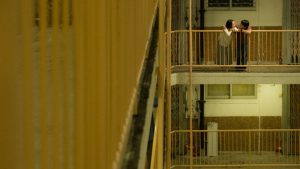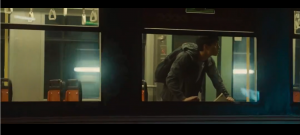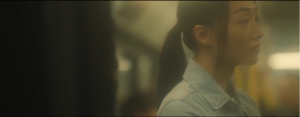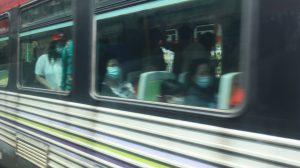BEYOND THE DREAM, DIR. KIWI CHOW (2019)
Tuen Mun, Tuen Mun District Hong Kong

Wu King Estate that Lee Chi Lok lives in and shown multiple times in the film that display features of living environment in Hong Kong. Scenes from Beyond the Dream, directed by Kiwi Chow
Beyond the Dream was released in November 2019 at the Hong Kong Asian Film Festival and released to the public in July 2020. The film tells the romance story between Lee Chi Lok, who recovered from schizophrenia and is afraid to love due to his psychiatric disorder, and Yan Yan/Yip Lam, a girl Lee Chi Lok met on the street that he fell in love with. Lee Chi Lok started having hallucinations of Yan Yan, seeing her and interacting with her on the light rail and in Wu King Estate, where both Lee Chi Lok and Yan Yan live in. Yan Yan is later shown to be a hallucination of Lee Chi Lok and the stranger that Lee Chi Lok is hallucinating about is revealed to be Yip Lam, a psychology student that wants to use Lee Chi Lok’s case for her graduation thesis.
Different elements of Tuen Mun such as light rails, housing estates, smaller local shopping malls and Tuen Mun Pier are shown in the film. The film portrays these places relatively similar to the actual places, showing features that can only be found in Hong Kong, such as the closeness of apartments in local housing estates from Lee Chi Lok hearing Yan Yan and her father argue to how Lee Chi Lok and Yip Lam can see each other’s home from their windows. Other than a really local portrayal of Tuen Mun, it is also portrayed to be dream like with the filters and lighting used. A lot of audiences describe it as “Japan-like” as it portrays elements exclusive to Tuen Mun, such as the light rail and Tuen Mun Pier that may be foreign to audiences that live elsewhere in Hong Kong. Although beautiful, there is a subtle melancholic feeling portrayed with the relatively less saturated colours and quiet background music.
The film is set in Tuen Mun after director Kiwi Chow discussed with writer Felix Tsang and decided that Lee Chi Lok, someone who is introverted and avoids human contact should not live in the city centre, while the writer lives in Tuen Mun so he can help find places for filming. Tuen Mun is represented as a dream like version of the real one, relating to how Yan Yan is a fantasy. Also because the filmmakers love for local and more nostalgic elements of Tuen Mun, such as the director choosing to wait for older light rail models due to his love for them. While dream-like, the elements included are still deeply local with nostalgic elements added in. The melancholy portrayed relates to how the characters are suppressing their mental problems, which related to one of the film’s message of how most of us, especially Hong Kong people, are mentally disturbed at different degrees and choose to suppress the emotions to act normal.
The filmmakers want to show their passion for both Hong Kong and Tuen Mun. The film tells Hong Kong citizens that there are undiscovered gems at their home city if they look deeper and with different perspectives.
— Liu Hoi Ching, 3035820291


Left, Lee Chi Lok looking for Yan Yan who passed by in the light rail train next to the one he is on. Scenes from Beyond the Dream, directed by Kiwi Chow. Right, Yan Yan on the light rail from Lee Chi Lok’s perspective, filmed with a filter to allude to the fact that she is a hallucination, and filmed with a warmer tone to show Lee Chi Lok’s warm loving feeling towards her. Scenes from Beyond the Dream, directed by Kiwi Chow

How it looks like when light rail trains pass each other, different from the warmer tone in the film. Photographed by Liu Hoi Ching
It is nice that you tried to analyze the atmosphere in the film to express the idea of fantasy/ dream. You also paid attention to details like the choice of older light rail models. The idea of nostalgia was mentioned in your piece. I wonder if you have discovered other elements in the story that support the point? The use of old light rail models is rather a subtle move to express such an idea. Would you extend this idea to the choice of old models of public housing estates? It would be interesting to see how your concepts on fantasy, nostalgia, and mental illness are linked to talk about the current Hong Kong situation. Despite being a fictional story, the mood and themes can be used as a lens to understand reality. Your piece will definitely be enriched with a more theoretical reading.